Change in Future Rainfall Characteristics in the Mekrou Catchment (Benin), from an Ensemble of 3 RCMs (MPI-REMO, DMI-HIRHAM5 and SMHI-RCA4)
Abstract
:1. Introduction
2. Study Area, Data and Method
3. Results
3.1. Mean Values of Study Parameters for Reference Period (1981–2010) in the Mekrou Basin at Kompongou
3.2. Future Changes in Precipitation Characteristics
3.2.1. Annual Precipitation Amounts
3.2.2. Number of Wet Days
3.2.3. Onset of the Rainy Seasons
3.2.4. End of the Rainy Seasons
3.2.5. Length of the Rainy Seasons
3.2.6. Length of Dry Spells
3.2.7. Total Precipitation Intensity of Very Wet Days
3.2.8. Maximum Precipitation Amounts During 24 Consecutive Hours
3.2.9. Maximum Precipitation Amounts During 48 Consecutive Hours
3.2.10. Maximum Precipitation Amounts during 72 Consecutive Hours
4. Discussion
5. Conclusions
Author Contributions
Conflicts of Interest
References
- Barrios, S.; Ouattara, B.; Strobl, E. The impact of climatic change on agricultural production: Is it different for Africa? Food Policy 2008, 33, 287–298. [Google Scholar] [CrossRef] [Green Version]
- Dang, H.; Gillett, N.P.; Weaver, A.J.; Zwiers, F.W. Climate change detection over different land surface vegetation classes. Int. J. Climatol. 2007, 27, 211–220. [Google Scholar] [CrossRef]
- IPCC. Climate Change 2001: The Climate Change. Contribution of the Working Group I to the Third Asseesment Report of the Intergovmmental Panel on Climate Change; Cambridge University Press: Cambridge, UK, 2001. [Google Scholar]
- Meissner, K.; Weaver, A.; Matthews, H.; Cox, P. The role of land surface dynamics in glacial inception: A study with the UVic Earth System Model. Clim. Dyn. 2003, 21, 515–537. [Google Scholar] [CrossRef]
- Snyder, P.; Delire, C.; Foley, J. Evaluating the influence of different vegetation biomes on the global climate. Clim. Dyn. 2004, 23, 279–302. [Google Scholar] [CrossRef]
- Tarhule, A. Damaging rainfall and flooding: The other Sahel hazards. Clim. Change 2005, 72, 355–377. [Google Scholar] [CrossRef]
- Karl, T.R.; Arguez, A.; Huang, B.; Lawrimore, J.H.; Menne, M.J.; Peterson, T.C.; Vose, R.S.; Zhang, H.M. Possible artifacts of data biases in the recent global surface warming hiatus. Science 2015, 348, 1469–1472. [Google Scholar] [CrossRef] [PubMed]
- IPCC. Climate Change 2013: The Physical Science Basis. Contribution of Working Group I to the Fifth Assessment Report of the Intergovernmental Panel on Climate Change; Cambridge University Press: Cambridge, UK; New York, NY, USA, 2013. [Google Scholar]
- Zwiers, F.W.; Alexander, L.V.; Hegerl, G.C.; Knutson, T.R.; Kossin, J.; Naveau, P.; Nicholls, N.; Schär, C.; Seneviratne, S.I.; Zhang, X. Challenges in estimating and understanding recent changes in the frequency and intensity of extreme climate and weather events. In Climate Science for Serving Society: Research, Modeling and Prediction Priorities; Springer: Berlin, Germany, 2013. [Google Scholar]
- Giorgi, F.; Coppola, E.; Raffaele, F. A consistent picture of the hydroclimatic response to global warming from multiple indices: Models and observations. J. Geophys. Res. Atmos. 2014, 119. [Google Scholar] [CrossRef]
- IPCC. Summary for Policymakers. In Climate Change 2014: Impacts, Adaptation, and Vulnerability. Contribution of Working Group II to the Fifth Assessment Report of the Intergovernmental Panel on Climate Change; Cambridge University Press: Cambridge, UK; New York, NY, USA, 2014. [Google Scholar]
- IPCC. Climate Change 2007—Synthesis Report. Intergovernmental Panel on Climate Change; Cambridge University Press: Cambridge, UK, 2007. [Google Scholar]
- Sylla, M.B.; Nikiema, P.M.; Gibba, P.; Kebe, I.; Klutse, N.A.B. Climate Change over West Africa: Recent Trends and Future Projections. In Adaptation to Climate Change and Variability in Rural West Africa; Springer: Basel, Switzerland, 2016. [Google Scholar]
- Tall, M.; Sylla, M.B.; Diallo, I.; Pal, J.S.; Faye, A.; Mbaye, M.L.; Gaye, A.T. Projected impact of climate change in the hydroclimatology of Senegal with a focus over the Lake of Guiers for the twenty-first century. Theor. Appl. Clim. 2016. [Google Scholar] [CrossRef]
- Ibrahim, B.; Karambiri, H.; Polcher, J.; Yacouba, H.; Ribstein, P. Changes in rainfall regime over Burkina Faso under the climate change conditions simulated by 5 regional climate models. Clim. Dyn. 2014, 42, 1363–1381. [Google Scholar] [CrossRef] [Green Version]
- Cook, K.H.; Vizy, E.K. Impact of climate change on mid-twenty-first century growing seasons in Africa. Clim. Dyn. 2012, 39, 2937–2955. [Google Scholar] [CrossRef]
- Elguindi, N.; Grundstein, A.; Bernardes, S.; Turuncoglu, U.; Feddema, J. Assessment of CMIP5 global model simulations and climate change projections for the 21st Century using a modified Thornthwaite climate classification. Clim. Chang. 2014, 122, 523–538. [Google Scholar] [CrossRef]
- Sylla, M.B.; Elguindi, N.; Giorgi, F.; Wisser, D. Projected robust shift of climate zones over West Africa in response to anthropogenic climate change for the late 21st century. Clim. Chang. 2016, 134, 241–253. [Google Scholar] [CrossRef]
- Gaba, O.U.C.; Biao, I.E.; Alamou, A.E.; Afouda, A. An Ensemble Approach Modelling to Assess Water Resources in the Mékrou Basin, Benin. IJCET 2015, 3, 22–32. [Google Scholar]
- GLEauBe. Etude Portant État Des Lieux et Gestion de L’information sur les Ressources en eau Dans le Bassin de la Mékrou; Rapport Technique: Cotonou, Benin, 2002; p. 104. [Google Scholar]
- Benoit, M. Statut et usages du sol en périphérie du parc national du “w” du Niger. Tome 1 Contribution à l’étude du milieu naturel et des ressources végétales du canton de Tamou et du Parc du ”W”; ORSTOM: Bondy, France, 1998. [Google Scholar]
- Obada, E.; Alamou, A.E.; Zandagba, E.J.; Biao, I.E.; Chabi, A.; Afouda, A. Comparative study of seven bias correction methods applied to three Regional Climate Models in Mekrou Catchment (Benin, West Africa). IJCET 2016, 6, 1831–1840. [Google Scholar]
- Christensen, O.B.; Drews, M.; Christensen, J.H. The HIRHAM regional climate model version 5. Available online: http://orbit.dtu.dk/fedora/objects/orbit:118724/datastreams/file_8c69af6e-acfb-4d1a-aa53-73188c001d36/content (accessed on 15 February 2017).
- Jacob, D.; Bärring, L.; Christensen, O.B.; Christensen, J.H.; Hagemann, S.; Hirschi, M.; Kjellström, E.; Lenderink, G.; Rockel, B.; Schär, C.; et al. An inter-comparison of regional climate models for Europe: Design of the experiments and model performance. Clim. Chang. 2007, 81, 31–52. [Google Scholar] [CrossRef]
- Samuelsson, P.; Jones, C.G.; Wille´n, U.; Ullerstig, A.; Gollvik, S.; Hansson, U.; Kjellström, E.; Nikulin, G.; Wyser, K. The Rossby Centre regional climate model RCA3: model description and performance. Tellus. A 2011, 63, 4–23. [Google Scholar] [CrossRef]
- Servat, E.; Paturel, J.E.; Kouamé, B.; Lubès-Niel, H.; Ouedraogo, M.; Masson, J.M. Climatic variability in humid Africa along the Gulfe of Guinea. Part I: Detailed analysis of the phenomenon in Côte d’Ivoire. J. Hydrol. 1997, 191, 1–15. [Google Scholar] [CrossRef]
- Servat, E.; Paturel, J.E.; Kouamé, B.; Travaglio, M.; Ouédraogo, M.; Boyer, J.F.; Lubès-Niel, H.; Fritsch, J.M.; Masson, J.M.; Marieu, B. Identification, caractérisation et conséquences d’une variabilité hydrologique en Afrique de l’Ouest et centrale. IAHS Publ. 1998, 252, 323–337. [Google Scholar]
- Servat, E.; Paturel, J.E.; Lubès-Niel, H.; Kouamé, B.; Masson, J.M.; Travaglio, M.; Marieu, B. De différents aspects de la variabilité de la pluviométrie en Afrique de l’ouest et centrale non sahélienne. Rev. Sci. Eau 1999, 12, 363–387. [Google Scholar] [CrossRef]
- Ardoin, S.; Lubès-Niel, H.; Servat, E.; Dezetter, A.; Boyer, J.F. Analyse de la persistance de la sécheresse en Afrique de l’Ouest: Caractérisation de la situation de la décennie 1990. IAHS Publi. 2003, 278, 223–228. [Google Scholar]
- Vissin, E.W.; Boko, M.; Perard, J.; Houndenou, C. Recherche de ruptures dans les séries pluviométriques et hydrologiques du bassin béninois du fleuve Niger (Bénin, Afrique de l'Ouest). Assoc. Int. Clim. 2003, 15, 368–376. [Google Scholar]
- Ardoin, S. Variabilité hydroclimatique et impacts sur les ressources en eau de grands bassins hydrographiques en zone soudano-sahélienne. Thèse de Doctorat, Université de Montpellier II, Monpellier, France, 2004. [Google Scholar]
- Kouassi, A.M.; Kouamé, K.F.; Goula, B.T.A.; Lasm, T.; Paturel, J.E.; Biémi, J. Influence de la variabilité climatique et de la modification de l’occupation du sol sur la relation pluie-débit à partir d’une modélisation globale du bassin versant du N’zi (Bandama) en Côte d’Ivoire. Revue Ivoirienne. des Sciences et Technologie 2008, 11, 207–229. [Google Scholar]
- Tapsobat, D. Caractérisation événementielle des régimes pluviométriques ouest-africains et de leur récent changement. Thèse de Doctorat, Université Paris XI (ORSAY), Paris, France, 1997. [Google Scholar]
- Nicholson, S. On the question of the “recovery” of the rains in the West African Sahel. J. Arid Environ. 2005, 63, 615–641. [Google Scholar] [CrossRef]
- Mahe, G.; Paturel, J.E. 1896–2006 Sahelian annual rainfall variability and runoff increase of Sahelian Rivers. C.R. Geosci. 2009, 341, 538–546. [Google Scholar] [CrossRef]
- Riede, J.O.; Posada, R.; Fink, A.H.; Kaspar, F. What’s on the 5th IPCC Report for West Africa? In Adaptation to Climate Change and Variability in Rural West Africa; Springer: Basel, Switzerland, 2016. [Google Scholar]
- Haarsma, R.J.; Selten, F.M.; Weber, S.L.; Kliphuis, M. Sahel rainfall variability and response to greenhouse warming. Geophys. Res. Lett. 2005, 32. [Google Scholar] [CrossRef]
- Ackerley, D.; Booth, B.B.B.; Knight, S.H.E.; Highwood, E.J.; Frame, D.J.; Allen, M.R.; Rowell, D.P. Sensitivity of twentieth-century sahel rainfall to sulfate aerosol and CO2 forcing. J. Clim. 2011, 24, 499–5014. [Google Scholar] [CrossRef]
- Biasutti, M. Forced Sahel rainfall trends in the CMIP5 archive. J. Geophys. Res.: Atmos. 2013, 118, 1613–1623. [Google Scholar] [CrossRef]
- Dong, B.W.; Sutton, R. Dominant role of greenhouse gas forcing in the recovery of Sahel rainfall. Nat. Clim. Chang. 2015, 5, 757–760. [Google Scholar] [CrossRef]
- Mohino, E.; Janicot, S.; Bader, J. Sahel rainfall and decadal to multi-decadal sea surface temperature variability. Clim. Dyn. 2011, 37, 419–440. [Google Scholar] [CrossRef]
- Liebmann, B. A definition for onset and end of the rainy season. 2006. Available online: www.eol.ucar.edu/projects/cppa/meetings/200608/posters/brant.pdf (accessed on 12 February 2007).
- WMO. Report on Drought and Countries Affected by Drought during 1974–1985; World Climate Programme 118; World Meteorological Organization: Geneva, Switzerland, 1986. [Google Scholar]
- WMO. Statistical distributions for flood frequency analysis. Oper. Hydrol. Rep. 1989, 33. WMO no 718. [Google Scholar]
- Dai, A. Increasing drought under global warming in observations and models. Nat. Clim. Chang. 2013, 3, 52–58. [Google Scholar] [CrossRef]
- Johns, T.; Gregory, J.; Ingram, W.; Johnson, C.; Jones, A.; Lowe, J.; Mitchell, J.; Roberts, D.; Sexton, D.; Stevenson, D.; et al. Anthropogenic climate change for 1860 to 2100 simulated with the HadCm3 model under updated emissions scenarios. Clim. Dyn. 2003, 20, 583–612. [Google Scholar]
- Sylla, M.B.; Giorgi, F.; Coppola, E.; Mariotti, L. Uncertainties in daily rainfall over Africa: Assessment of observation products and evaluation of a regional climate model simulation. Int. J. Climatol. 2013, 33, 1805–1817. [Google Scholar] [CrossRef]
- Sylla, M.B.; Dell’Aquila, A.; Ruti, P.M.; Giorgi, F. Simulation of the intraseasonal and the interannual variability of rainfall over West Africa with RegCM3 during the monsoon period. Int. J. Climatol. 2010, 30, 1865–1883. [Google Scholar] [CrossRef]
- Lintner, B.R.; Biasutti, M.; Diffenbaugh, N.S.; Lee, J.E.; Niznik, M.J.; Findell, K.L. Amplification of wet and dry month occurrence over tropical land regions in response to global warming. J. Geophys. Res. 2012, 117, D11106. [Google Scholar] [CrossRef]
- Scoccimarro, E.; Gualdi, S.; Bellucci, A.; Zampieri, M.; Navarra, A. Heavy precipitation events In a warmer climate: results from CMIP5 models. J. Clim. 2013, 26, 7902–7911. [Google Scholar] [CrossRef]
- Abiodun, B.J.; Lawal, K.A.; Salami, A.T.; Abatan, A.A. Potential influences of global warming on future climate and extreme events in Nigeria. Reg. Environ. Chang. 2013, 477–491. [Google Scholar] [CrossRef]
- Giorgi, F.; Coppola, E.; Raffaele, F.; Diro, G.T.; Fuentes-Franco, R.; Giuliani, G.; Mamgain, A.; Llopart, M.P.; Mariotti, L.; Torma, C. Changes in extremes and hydroclimatic regimes in the CREMA ensemble projections. Clim. Chang. 2014, 125, 39–51. [Google Scholar] [CrossRef]
- Giorgi, F.; Im, E.S.; Coppola, E.; Diffenbaugh, N.S.; Gao, X.J.; Mariotti, L.; Shi, Y. Higher hydroclimatic intensity with global warming. J. Clim. 2011, 24, 5309–5324. [Google Scholar] [CrossRef]
- Sylla, M.B.; Gaye, A.T.; Jenkins, G.S. On the fine-scale topography regulating changes in atmospheric hydrological cycle and extreme rainfall over West Africa in a regional climate model projections. Int. J. Geophys. 2012, 981649. [Google Scholar] [CrossRef]
- Sylla, M.B.; Giorgi, F.; Pal, J.S.; Gibba, P.; Kebe, I.; Nikiema, M. Projected changes in the annual cycle of high intensity precipitation events over West Africa for the late 21st century. J. Clim. 2015, 28, 6475–6488. [Google Scholar] [CrossRef]


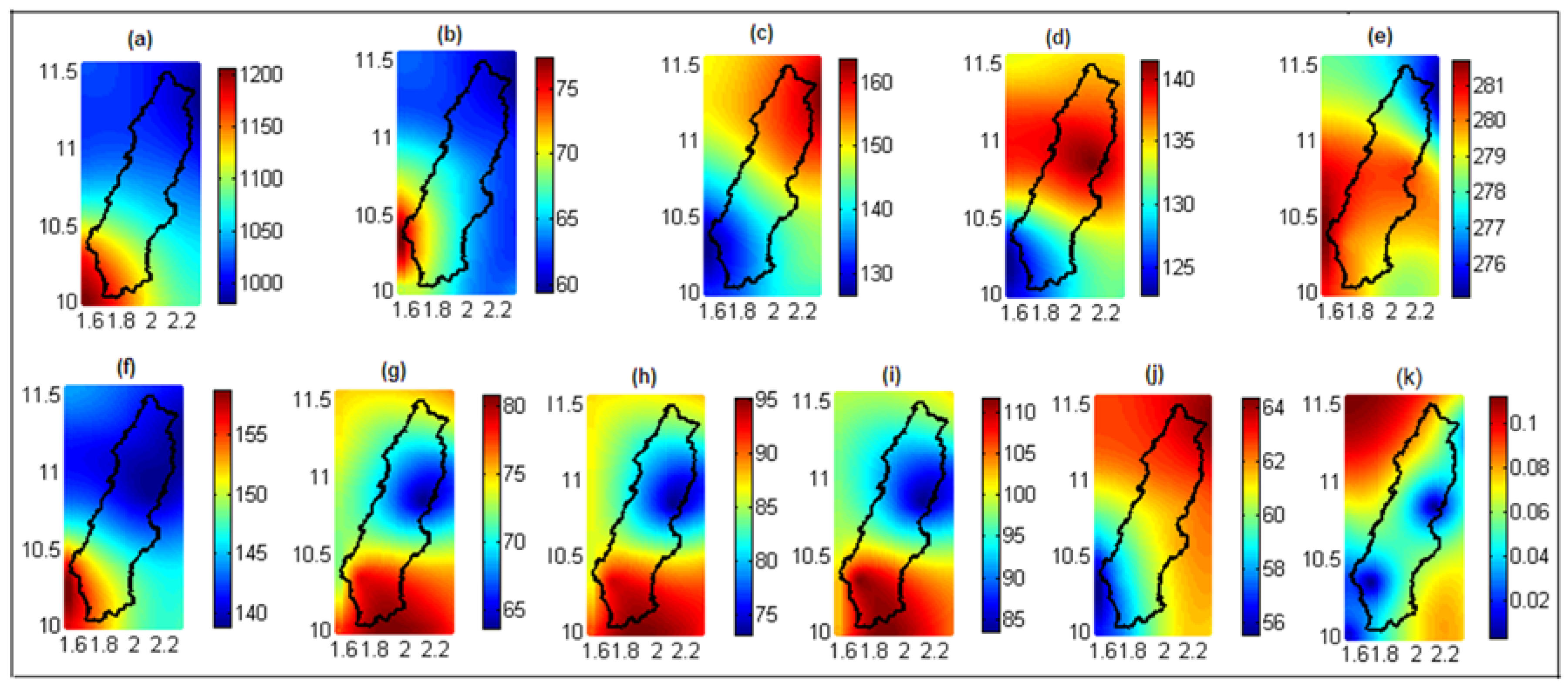
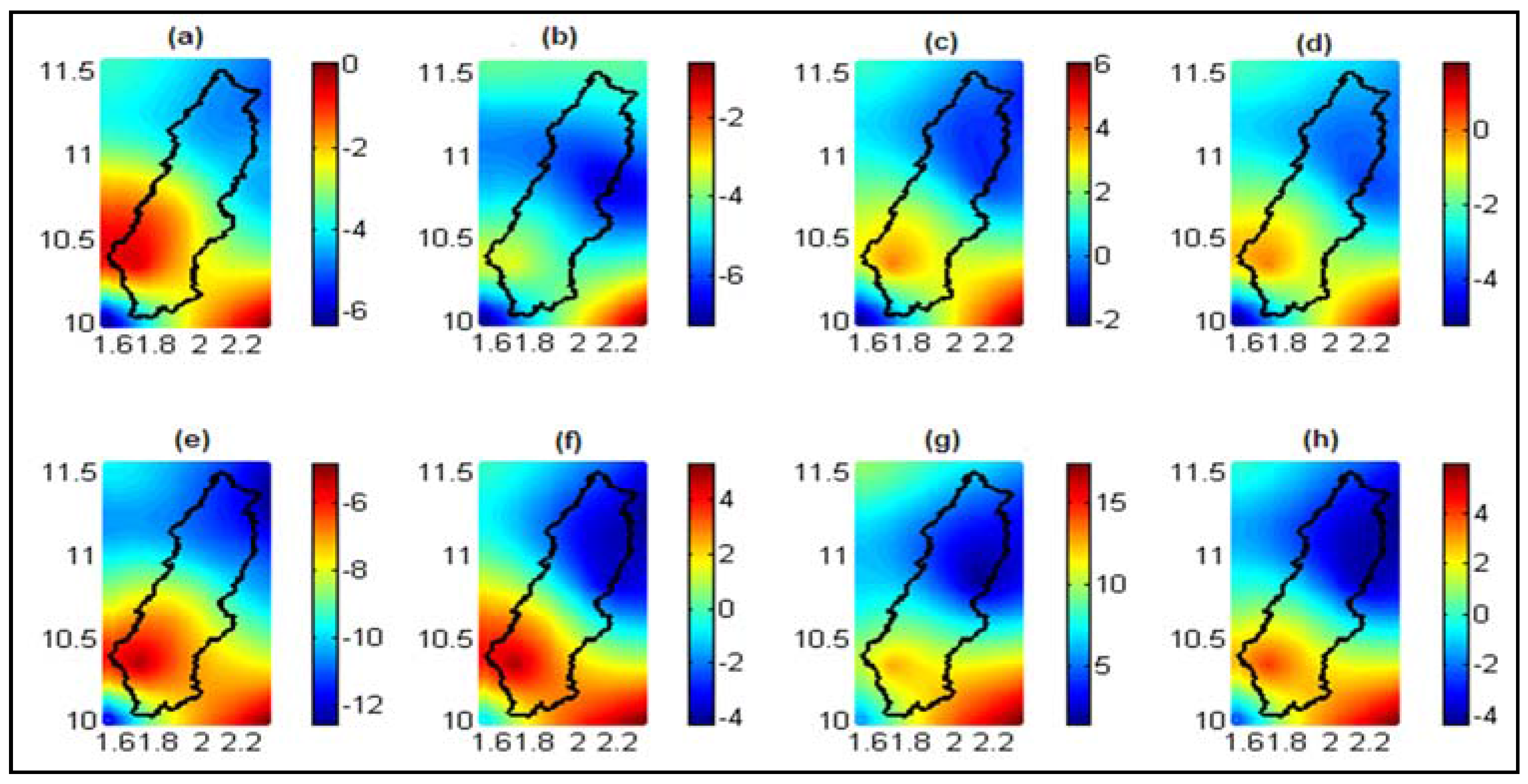
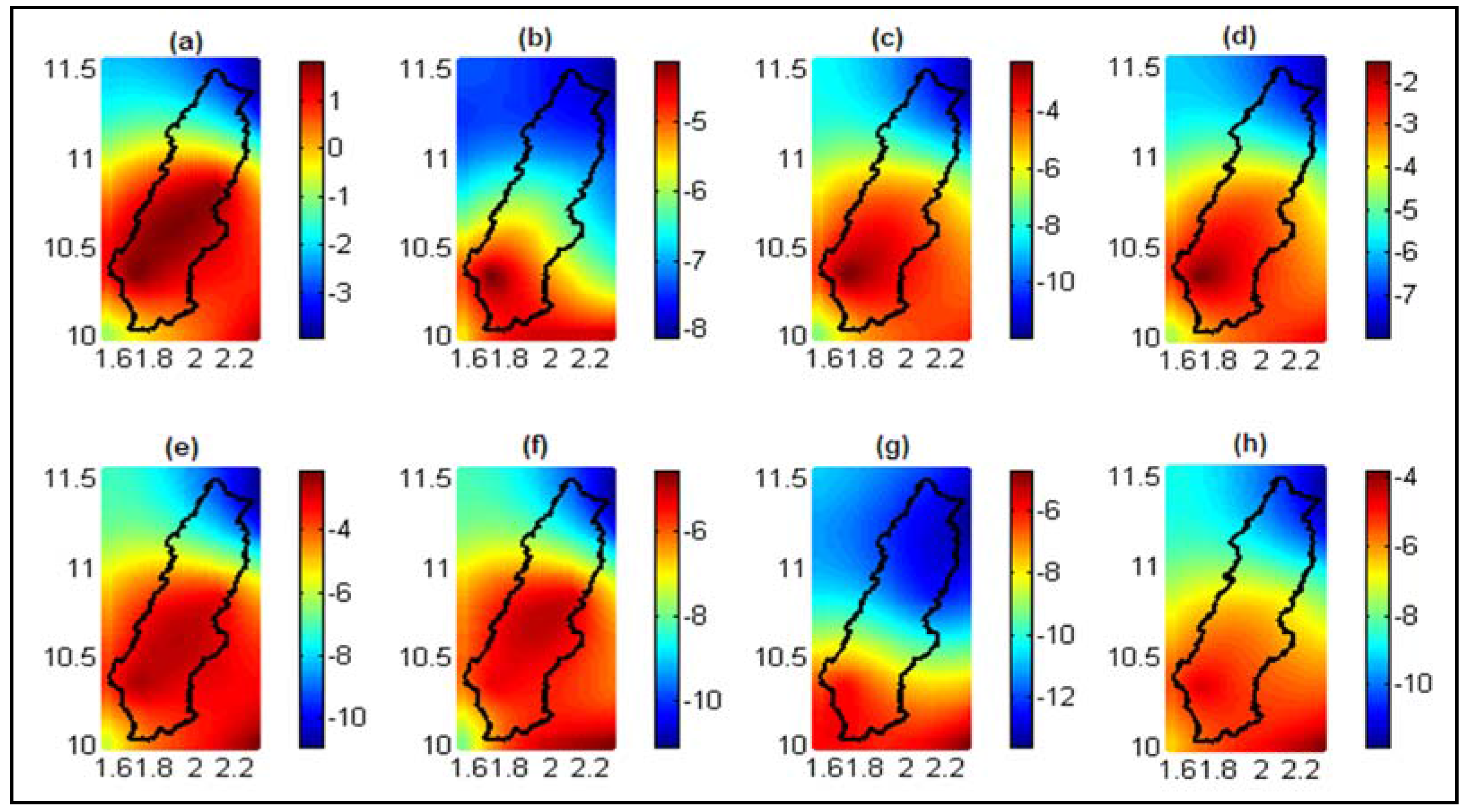


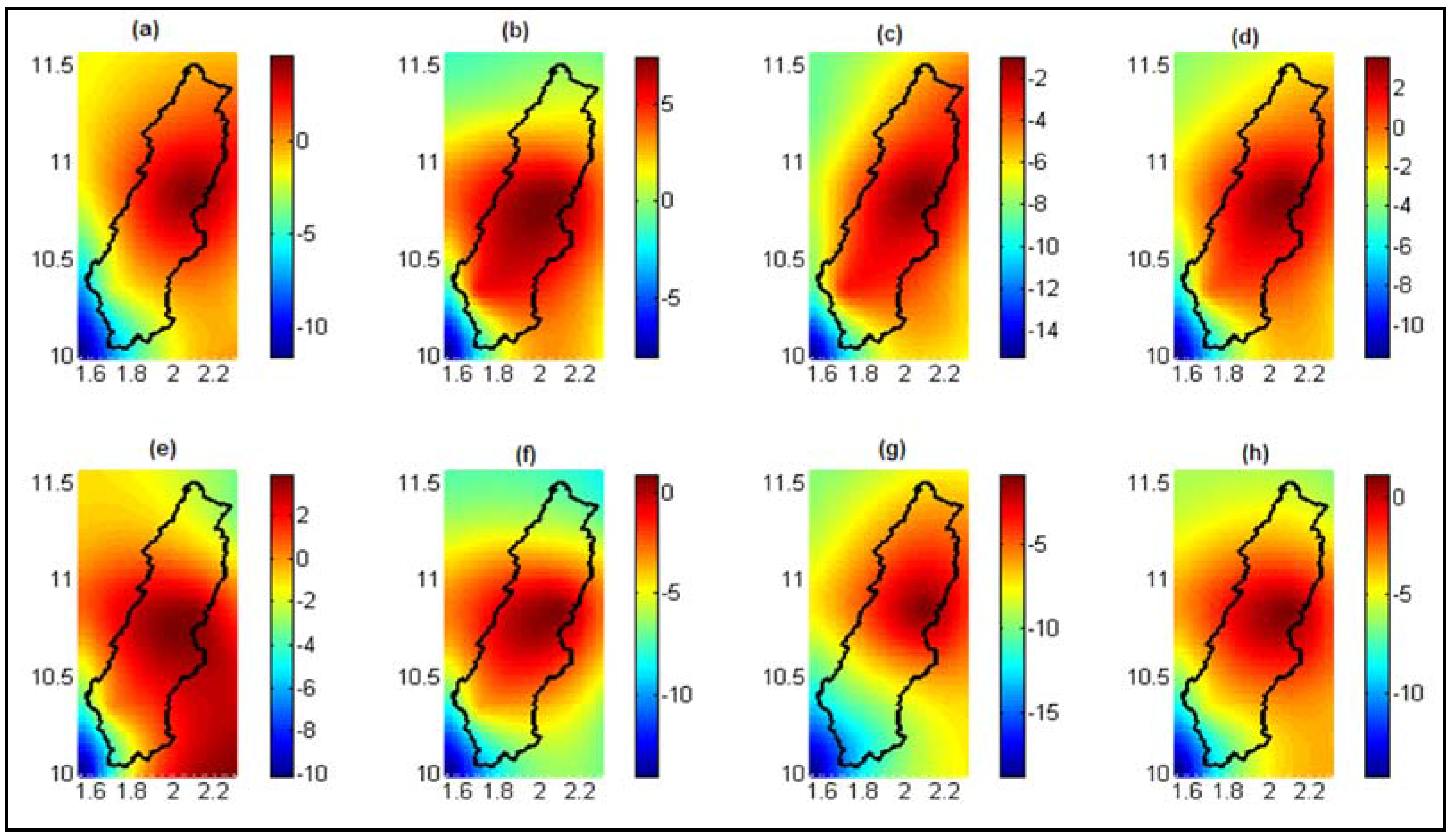
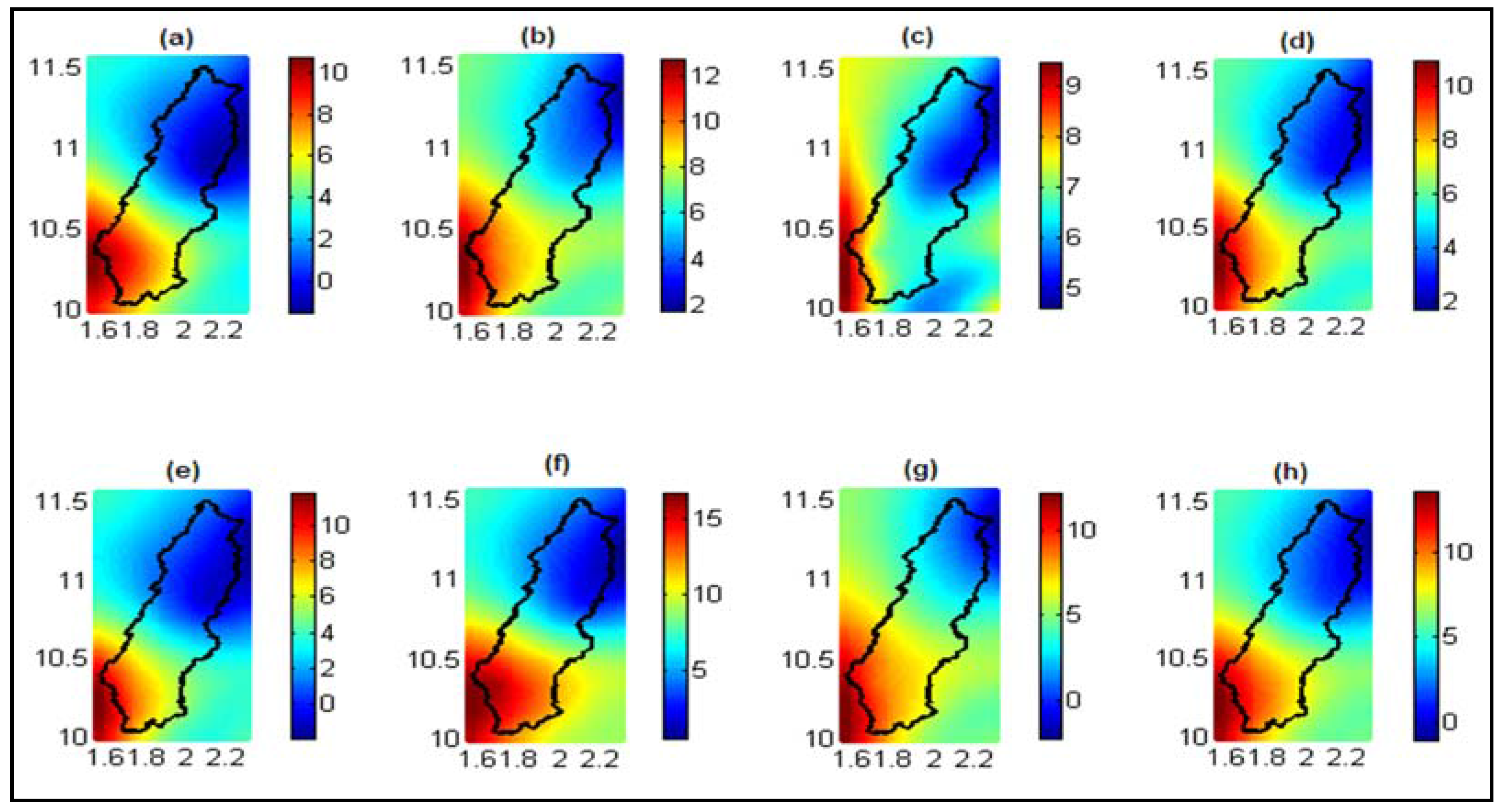
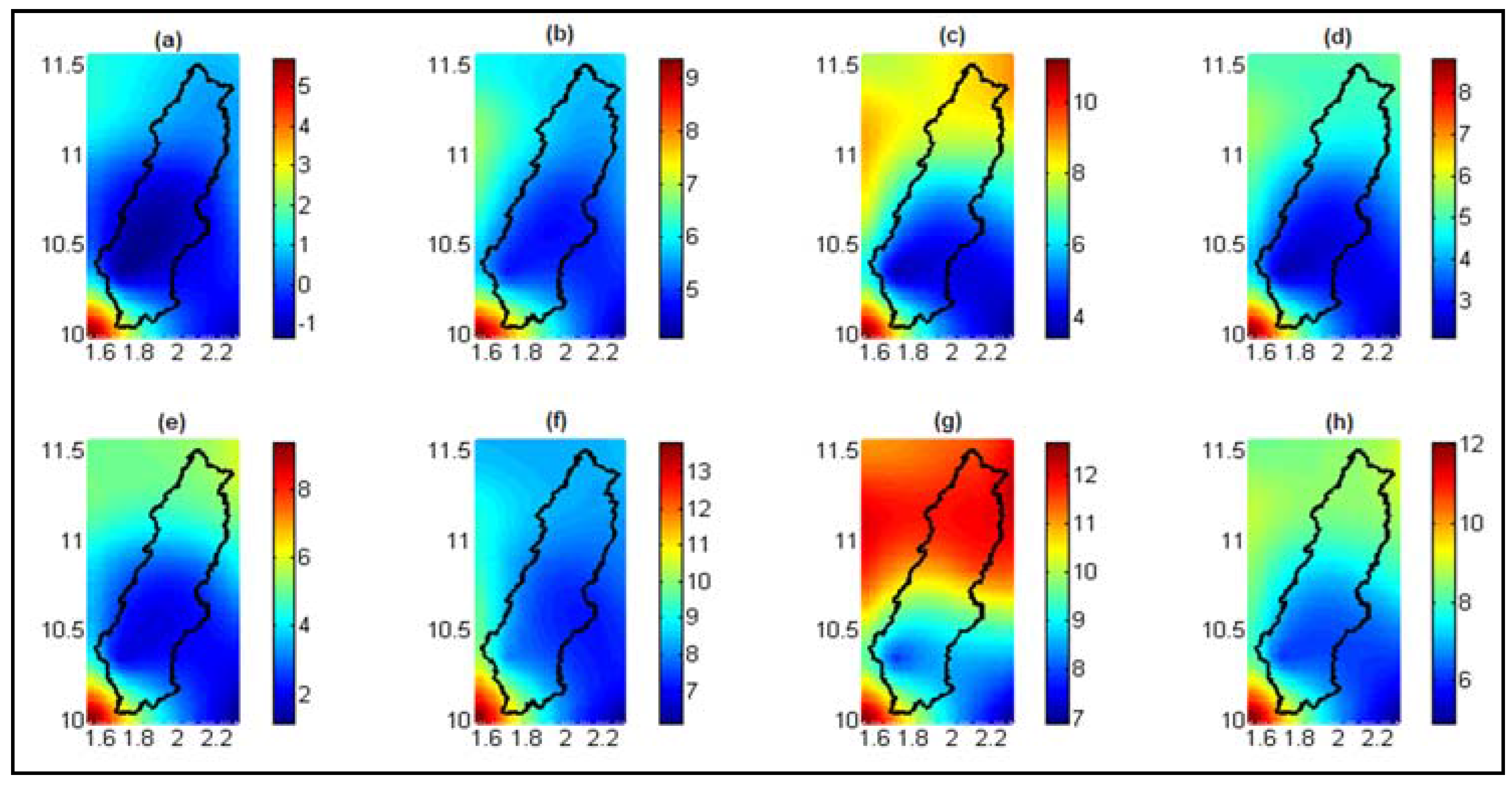
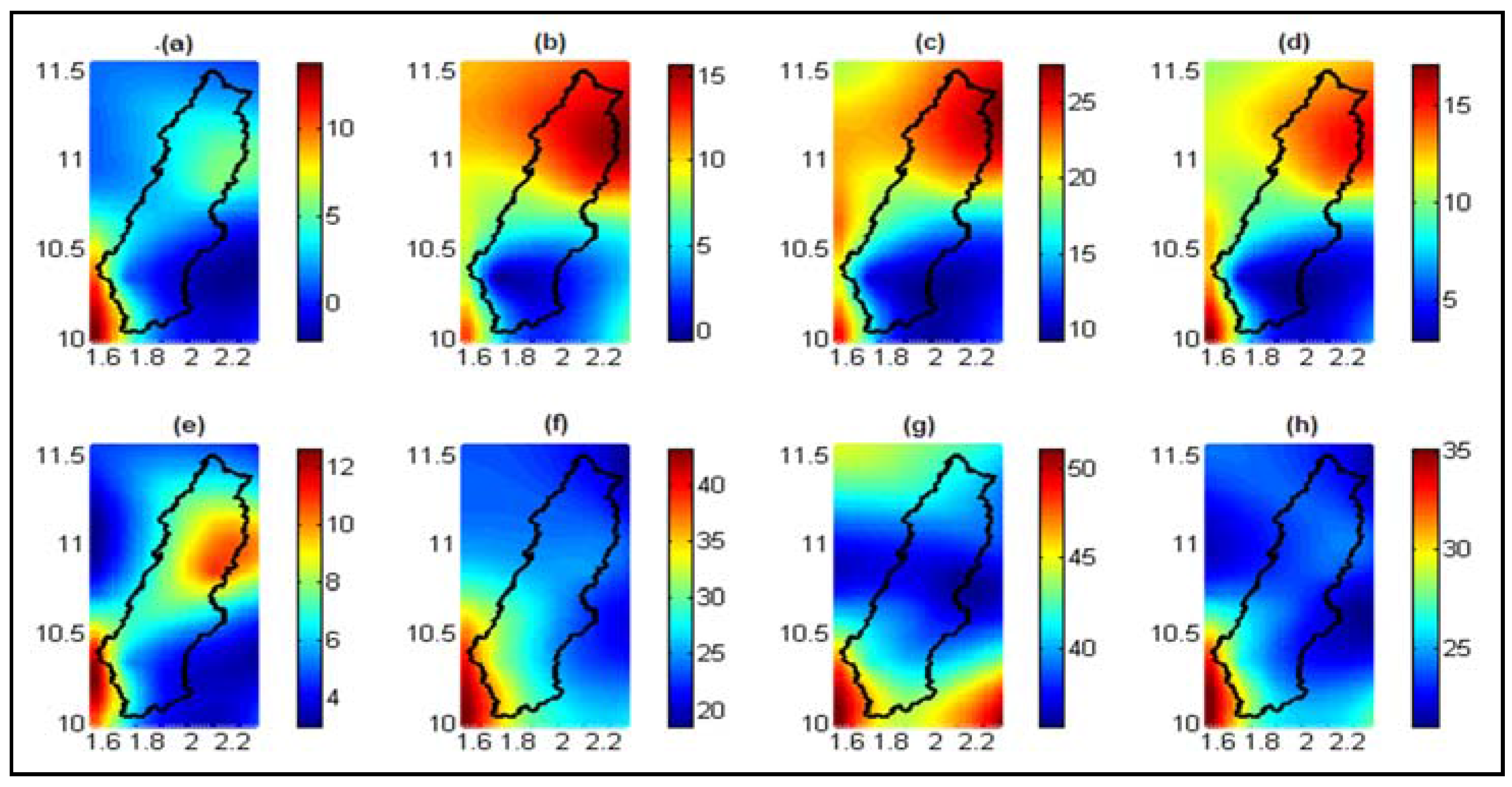
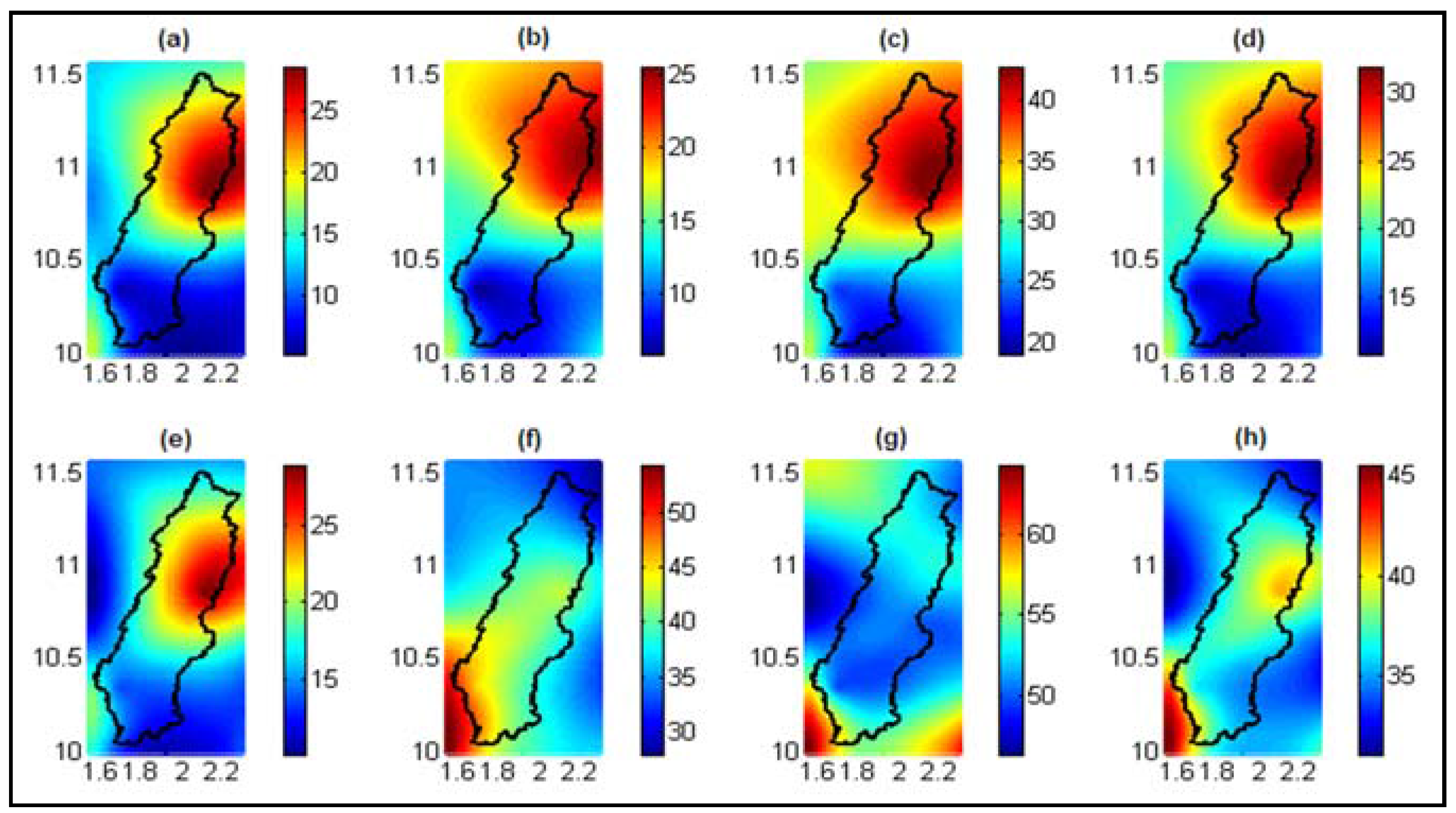
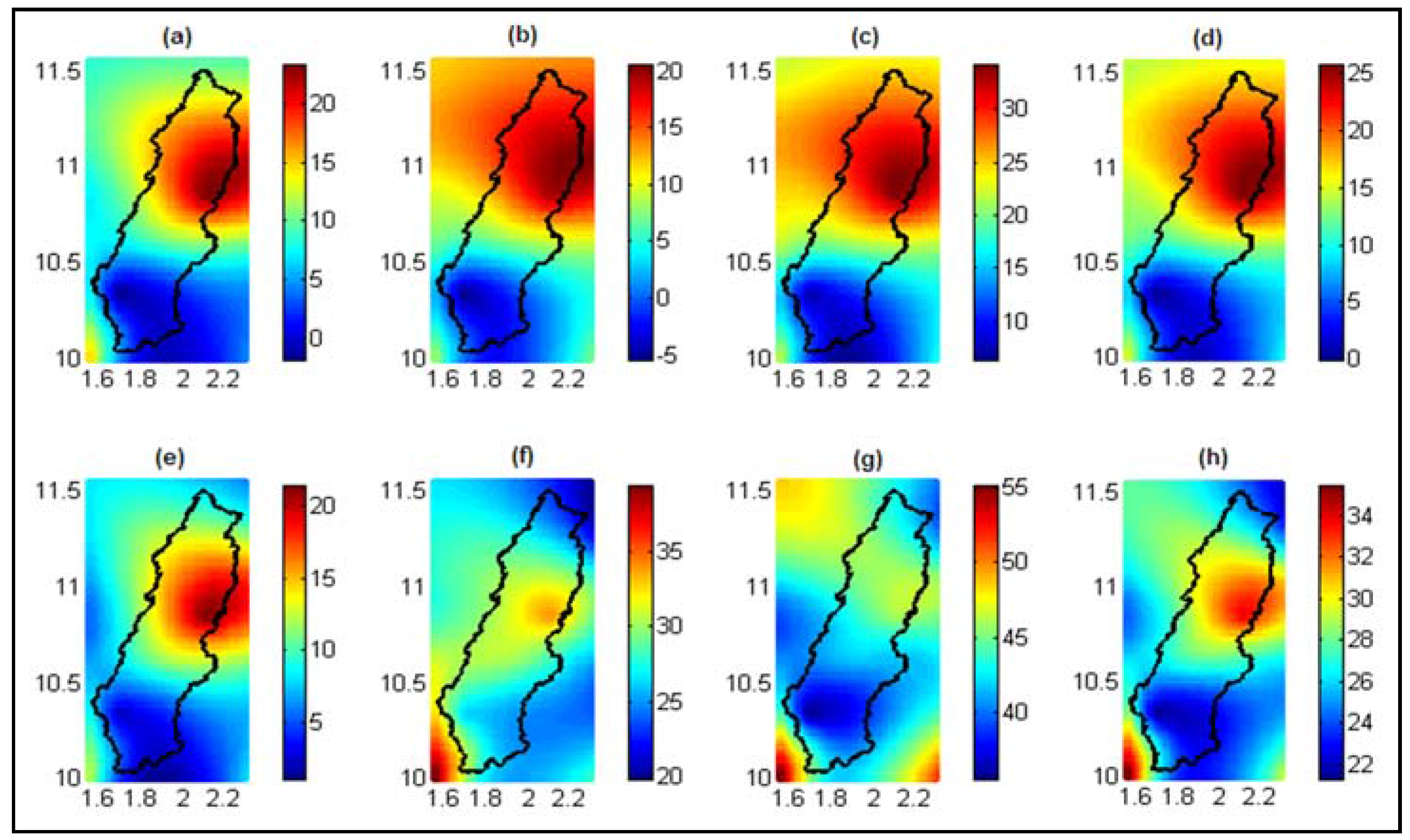
© 2017 by the authors. Licensee MDPI, Basel, Switzerland. This article is an open access article distributed under the terms and conditions of the Creative Commons Attribution (CC BY) license ( http://creativecommons.org/licenses/by/4.0/).
Share and Cite
Obada, E.; Alamou, E.A.; Zandagba, J.; Chabi, A.; Afouda, A. Change in Future Rainfall Characteristics in the Mekrou Catchment (Benin), from an Ensemble of 3 RCMs (MPI-REMO, DMI-HIRHAM5 and SMHI-RCA4). Hydrology 2017, 4, 14. https://doi.org/10.3390/hydrology4010014
Obada E, Alamou EA, Zandagba J, Chabi A, Afouda A. Change in Future Rainfall Characteristics in the Mekrou Catchment (Benin), from an Ensemble of 3 RCMs (MPI-REMO, DMI-HIRHAM5 and SMHI-RCA4). Hydrology. 2017; 4(1):14. https://doi.org/10.3390/hydrology4010014
Chicago/Turabian StyleObada, Ezéchiel, Eric Adéchina Alamou, Josué Zandagba, Amédée Chabi, and Abel Afouda. 2017. "Change in Future Rainfall Characteristics in the Mekrou Catchment (Benin), from an Ensemble of 3 RCMs (MPI-REMO, DMI-HIRHAM5 and SMHI-RCA4)" Hydrology 4, no. 1: 14. https://doi.org/10.3390/hydrology4010014





